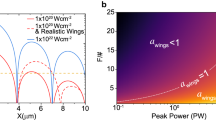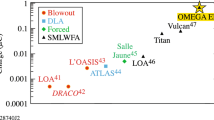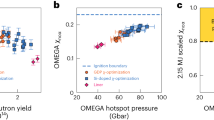Abstract
The prediction that laser plasma heating distorts the electron distribution function away from Maxwellian and towards a super-Gaussian distribution dates back four decades1. In conditions relevant to inertial confinement fusion, however, no direct evidence of this so-called ‘Langdon effect’ has previously been observed. Here we present measurements of the spatially and temporally resolved Thomson scattering spectrum that indicate the presence of super-Gaussian electron distribution functions consistent with existing theory2. In such plasmas, ion acoustic wave frequencies increase monotonically with the super-Gaussian exponent3. Our results show that the measured power transfer between crossed laser beams mediated by ion acoustic waves requires a model that accounts for the non-Maxwellian electron distribution function, whereas the standard Maxwellian calculations overpredict power transfer over a wide region of parameter space. Including this effect is expected to improve the predictive capability of crossed-beam energy transfer modelling at the National Ignition Facility in California and may restore a larger operable design space for inertial confinement fusion experiments. This is also expected to motivate further inquiry in other areas affected by non-Maxwellian electron distribution functions, such as laser absorption, heat transport and X-ray spectroscopy.
This is a preview of subscription content, access via your institution
Access options
Access Nature and 54 other Nature Portfolio journals
Get Nature+, our best-value online-access subscription
$29.99 / 30 days
cancel any time
Subscribe to this journal
Receive 12 print issues and online access
$209.00 per year
only $17.42 per issue
Buy this article
- Purchase on Springer Link
- Instant access to full article PDF
Prices may be subject to local taxes which are calculated during checkout





Similar content being viewed by others
Data availability
Source Data for Fig. 2b,c are provided with the paper. All other data that support the plots within this paper and other findings of this study are available from the corresponding author upon reasonable request.
Code availability
The computer programs that support the findings of this study are available from the corresponding author upon reasonable request.
References
Langdon, A. B. Nonlinear inverse bremsstrahlung and heated-electron distributions. Phys. Rev. Lett. 44, 575–579 (1980).
Matte, J. P. et al. Non-Maxwellian electron distributions and continuum X-ray emission in inverse bremsstrahlung heated plasmas. Plasma Phys. Control. Fusion 30, 1665–1689 (1988).
Afeyan, B. B., Chou, A. E., Matte, J. P., Town, R. P. J. & Kruer, W. J. Kinetic theory of electron-plasma and ion-acoustic waves in nonuniformly heated laser plasmas. Phys. Rev. Lett. 80, 2322–2325 (1998).
Betti, R. & Hurricane, O. A. Inertial-confinement fusion with lasers. Nat. Phys. 12, 435–448 (2016).
Michel, P. et al. Tuning the implosion symmetry of ICF targets via controlled crossed-beam energy transfer. Phys. Rev. Lett. 102, 025004 (2009).
Glenzer, S. H. et al. Symmetric inertial confinement fusion implosions at ultra-high laser energies. Science 327, 1228–1231 (2010).
Moody, J. D. et al. Multistep redirection by cross-beam power transfer of ultrahigh-power lasers in a plasma. Nat. Phys. 8, 344–349 (2012).
Michel, P. et al. Stochastic ion heating from many overlapping laser beams in fusion plasmas. Phys. Rev. Lett. 109, 195004 (2012).
Clark, D. S. et al. Three-dimensional simulations of low foot and high foot implosion experiments on the National Ignition Facility. Phys. Plasmas 23, 056302 (2016).
Strozzi, D. J. et al. Interplay of laser-plasma interactions and inertial fusion hydrodynamics. Phys. Rev. Lett. 118, 025002 (2017).
Berzak Hopkins, L. F. et al. First high-convergence cryogenic implosion in a near-vacuum hohlraum. Phys. Rev. Lett. 114, 175001 (2015).
Hinkel, D. E. et al. Development of improved radiation drive environment for high foot implosions at the National Ignition Facility. Phys. Rev. Lett. 117, 225002 (2016).
Baker, K. L. et al. High-performance indirect-drive cryogenic implosions at high adiabat on the National Ignition Facility. Phys. Rev. Lett. 121, 135001 (2018).
Kritcher, A. L. et al. Energy transfer between lasers in low-gas-fill-density hohlraums. Phys. Rev. E 98, 053206 (2018).
Kirkwood, R. K. et al. Observation of energy transfer between frequency-mismatched laser beams in a large-scale plasma. Phys. Rev. Lett. 76, 2065–2068 (1996).
Turnbull, D. et al. Refractive index seen by a probe beam interacting with a laser-plasma system. Phys. Rev. Lett. 118, 015001 (2017).
Kirkwood, R. K. et al. Plasma-based beam combiner for very high fluence and energy. Nat. Phys. 14, 80–84 (2018).
Dum, C. T. Anomalous heating by ion sound turbulence. Phys. Fluids 21, 945–955 (1978).
Dum, C. T. Anomalous electron transport equations for ion sound and related turbulent spectra. Phys. Fluids 21, 956–969 (1978).
Liu, J. M., De Groot, J. S., Matte, J. P., Johnston, T. W. & Drake, R. P. Measurements of inverse bremsstrahlung absorption and non-Maxwellian electron velocity distributions. Phys. Rev. Lett. 72, 2717–2720 (1994).
Zheng, J., Yu, C. X. & Zheng, Z. J. Effects of non-Maxwellian (super-Gaussian) electron velocity distribution on the spectrum of Thomson scattering. Phys. Plasmas 4, 2736–2740 (1997).
Milder, A. L., Ivancic, S. T., Palastro, J. P. & Froula, D. H. Impact of non-Maxwellian electron velocity distribution functions on inferred plasma parameters in collective Thomson scattering. Phys. Plasmas 26, 022711 (2019).
Colaitis, A., Palastro, J. P., Follett, R. K., Igumenschev, I. V. & Goncharov, V. Real and complex valued geometrical optics inverse ray-tracing for inline field calculations. Phys. Plasmas 26, 032301 (2019).
Colaitis, A., Follett, R. K., Palastro, J. P., Igumenshchev, I. & Goncharov, V. N. Adaptive inverse ray-tracing for accurate and efficient modeling of cross beam energy transfer in hydrodynamics simulations. Phys. Plasmas 26, 072706 (2019).
Epperlein, E. M. & Short, R. W. Nonlocal electron transport in the presence of high-intensity laser irradiation. Phys. Rev. E 50, 1697–1699 (1994).
Batishchev, O. V. et al. Heat transport and electron distribution function in laser produced plasmas with hot spots. Phys. Plasmas 9, 2302–2310 (2002).
Barrios, M. A. et al. Developing an experimental basis for understanding transport in NIF hohlraum plasmas. Phys. Rev. Lett. 121, 095002 (2018).
Bissell, J. J., Ridgers, C. P. & Kingham, R. J. Super-Gaussian transport theory and the field-generating thermal instability in laser-plasmas. New J. Phys. 15, 025017 (2013).
Seka, W. et al. Nonuniformly driven two-plasmon-decay instability in direct-drive implosions. Phys. Rev. Lett. 112, 145001 (2014).
Dorrer, C. et al. Spectrally tunable, temporally shaped parametric front end to seed high-energy Nd:glass laser systems. Opt. Exp. 25, 26802–26814 (2017).
Kruschwitz, B. E. et al. Tunable UV upgrade on OMEGA EP. Proc. SPIE High Power Lasers for Fusion Research V 10898, 1089804 (2019).
Semushin, S. & Malka, V. High density gas jet nozzle design for laser target production. Rev. Sci. Instrum. 72, 2961–2965 (2001).
Boehly, T. R. et al. Reduction of laser imprinting using polarization smoothing on a solid-state fusion laser. J. Appl. Phys. 85, 3444–3447 (1999).
Froula, D. H., Glenzer, S. H., Luhmann, N. C. & Sheffield, J. Plasma Scattering of Electromagnetic Radiation 2nd edn (Academic Press, 2011).
Katz, J. et al. A reflective optical transport system for ultraviolet Thomson scattering from electron plasma waves on OMEGA. Rev. Sci. Instrum. 83, 10E349 (2012).
Acknowledgements
This material is based upon work supported by the Department of Energy National Nuclear Security Administration under award number DE-NA0003856, the University of Rochester, and the New York State Energy Research and Development Authority. This report was prepared as an account of work sponsored by an agency of the US Government. Neither the US Government nor any agency thereof, nor any of their employees, makes any warranty, express or implied, or assumes any legal liability or responsibility for the accuracy, completeness, or usefulness of any information, apparatus, product, or process disclosed, or represents that its use would not infringe privately owned rights. Reference herein to any specific commercial product, process, or service by trade name, trademark, manufacturer, or otherwise does not necessarily constitute or imply its endorsement, recommendation, or favouring by the US Government or any agency thereof. The views and opinions of authors expressed herein do not necessarily state or reflect those of the US Government or any agency thereof.
Author information
Authors and Affiliations
Contributions
D.T. was the Principal Investigator (PI) for the experimental campaign. A.C. was the theory and modelling PI. D.H.F. was the experimental plasma physics group leader. Other authors contributed as follows: experimental support and plasma characterization (A.M.H.); non-Maxwellian electron susceptibility calculations (A.L.M.); theory support (J.P.P.); instrument specialist (J.K.); laser specialists (C.D. and B.E.K.); motivational discussions and supporting simulations (D.J.S.).
Corresponding author
Ethics declarations
Competing interests
The authors declare no competing interests.
Additional information
Publisher’s note Springer Nature remains neutral with regard to jurisdictional claims in published maps and institutional affiliations.
Extended data
Extended Data Fig. 1 Tabulated Langdon effect intensity scaling plasma characterization results.
Different experiments were conducted in which the number of beams present after an initial plasma-forming period was varied from 1 to 4, each having nominally identical power and spatial smoothing. Overlapped intensity therefore scaled linearly with the number of beams. This resulted in an increase of more than threefold in the Langdon parameter (α) despite the moderating influence of the higher electron temperature. In each case, the super-Gaussian exponent, m, of the EDF measured by Thomson scattering was found to be in excellent agreement with the value expected from equation (3).
Source data
Source Data Fig. 2
EPW and IAW Thomson scattering spectra for the data and time indicated in Fig. 2, which require a non-Maxwellian EDF and cannot be fitted adequately using the typical Maxwellian assumption.
Rights and permissions
About this article
Cite this article
Turnbull, D., Colaïtis, A., Hansen, A.M. et al. Impact of the Langdon effect on crossed-beam energy transfer. Nat. Phys. 16, 181–185 (2020). https://doi.org/10.1038/s41567-019-0725-z
Received:
Accepted:
Published:
Issue Date:
DOI: https://doi.org/10.1038/s41567-019-0725-z



